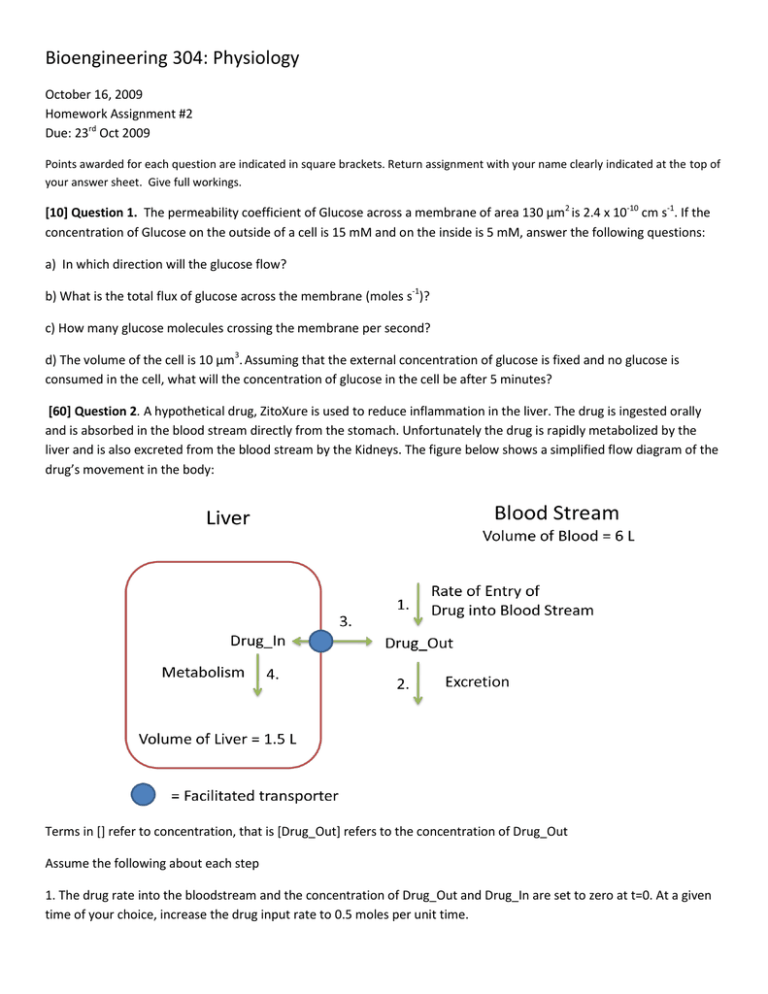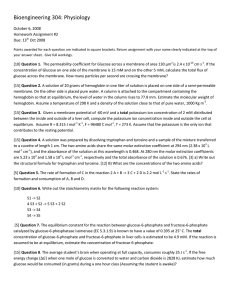Bioengineering 304: Physiology October 16, 2009 Homework Assignment #2 Due: 23
advertisement

Bioengineering 304: Physiology October 16, 2009 Homework Assignment #2 Due: 23rd Oct 2009 Points awarded for each question are indicated in square brackets. Return assignment with your name clearly indicated at the top of your answer sheet. Give full workings. [10] Question 1. The permeability coefficient of Glucose across a membrane of area 130 µm2 is 2.4 x 10-10 cm s-1. If the concentration of Glucose on the outside of a cell is 15 mM and on the inside is 5 mM, answer the following questions: a) In which direction will the glucose flow? b) What is the total flux of glucose across the membrane (moles s-1)? c) How many glucose molecules crossing the membrane per second? d) The volume of the cell is 10 µm3. Assuming that the external concentration of glucose is fixed and no glucose is consumed in the cell, what will the concentration of glucose in the cell be after 5 minutes? [60] Question 2. A hypothetical drug, ZitoXure is used to reduce inflammation in the liver. The drug is ingested orally and is absorbed in the blood stream directly from the stomach. Unfortunately the drug is rapidly metabolized by the liver and is also excreted from the blood stream by the Kidneys. The figure below shows a simplified flow diagram of the drug’s movement in the body: Terms in [] refer to concentration, that is [Drug_Out] refers to the concentration of Drug_Out Assume the following about each step 1. The drug rate into the bloodstream and the concentration of Drug_Out and Drug_In are set to zero at t=0. At a given time of your choice, increase the drug input rate to 0.5 moles per unit time. 2. The excretion rate, in moles per unit time, is given by the k1 x [Drug_Out] x V_Blood Set k1 = 0.3 per unit time V_Blood = 6 L 3. Membrane flux, assume a permeability coefficient of 5 and an area of 1 unit area. 4. The metabolic rate, in moles per unit time, is given by k2 x [Drug_In] x V_Liver Set k2 = 0.1 per unit time V_Liver = 1.5 L a) Build a differential equation model of this system (using Matlab for example) that describes how the level of drug inside the liver varies with time. Using the model, predict the maximum level (concentration) of drug inside the liver compartment when the drug is released for four time units at a rate of 0.5 moles per unit time. That is, assume that the drug rate of entry into the bloodstream is given by single square wave cycle as shown below: Drug pulse: b) What happens to the maximum level of drug in the liver if the blood volume is doubled to 12 L? Hints: 1. The differential equations in your model should compute the rate of change of amounts so that you can accommodate the difference in volumes between the liver compartment and the blood stream. 2. Make sure your equations obey the conservation of mass, this is critical to setting up your model. Points will be awarded for model construction, simulations and correct results. [15] Question 3. A solution of 20 grams of hemoglobin in one liter of solution is placed on one side of a semi-permeable membrane. On the other side is placed pure water. A column is attached to the compartment containing the hemoglobin so that at equilibrium, the level of water in the column rises to 77.8 mm. Estimate the molecular weight of hemoglobin. Assume a temperature of 298 K and a density of the solution close to that of pure water, 1000 Kg m-3. [15] Question 4. Given a membrane potential of -60 mV and a total potassium ion concentration of 2 mM distributed between the inside and outside of a liver cell, compute the potassium ion concentration inside and outside the cell at equilibrium. Assume R = 8.315 J mol-1 K-1, F = 96480 C mol-1, T = 273 K. Assume that the potassium is the only ion that contributes to the resting potential. You can also assume that the volume of the liver and cell and the volume outside the liver cell are equal.





